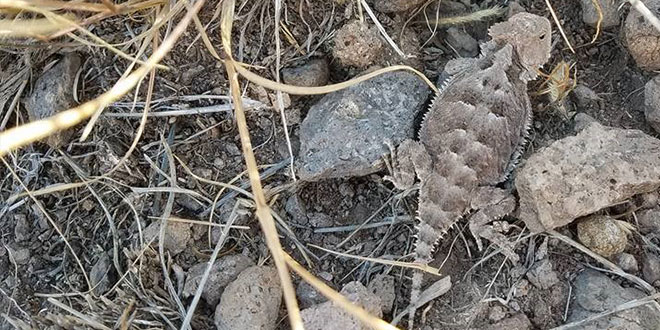Have you ever been startled by walking right up on a rabbit or quail before it bolts out of its hiding spot and surprises you? You didn’t see the animal because it was using camouflage!
Camouflage is an animal’s coloration that helps it go unnoticed. This coloration could conceal the animal, like a mule deer’s pelage – or fur coat color – blending in with the vegetation and soils of its environment. Camouflage can also make an animal more boldly colored and help break up the animal’s outline – like a striped whipsnake – making it confusing to predators. Take a look at the photo above. Can you see the greater short-horned lizard camouflaged in the rocks?
Camouflage is used by predators, too. Think of how a mountain lion’s pelage blends in with grasses and other plants as it slowly stalks its prey.
In the following activity, you will become a hungry predator and see how camouflage helps an animal go unnoticed.
Materials:
1. Two kinds of similar, dried beans – like black-eyed peas and black beans. 60 of each type.
2. A pie tin or plate to put the beans in. (Just make sure the beans are close together and not too spread out.)
3. 10-second timer
4. Paper and pencil/pen to record results
Instructions:
1. Start with only one type of bean on your pie tin or plate. Explain to the student(s) that they will have 10 seconds to remove as many beans as they can, using only their first finger and thumb of one hand. They should remove only one bean at a time.
2. Set a timer for 10 seconds and tell the student(s) to start.
3. After 10 seconds have elapsed, have the students count the number of beans they removed and record it. For advanced students, have them calculate the percentage of the beans they removed from the starting total.
4. Next, mix both types of beans together in the pie tin or plate.
5. Explain to the student(s) that they will now have 10 seconds to pick out as many of one type of bean (your choice) as they can, using only their first finger and thumb, and still just one bean at a time.
6. Set a timer for 10 seconds and tell the student(s) to start.
7. After time has ended, have the student(s) count the number of beans they removed. Again, percentages of what was removed and what remains can be calculated. A percentage change from the number of beans removed in Step 1 versus Step 5 can also be calculated.
Bonus: Mix the beans again and give the student(s) 10 seconds to remove beans (still using only their first finger and thumb on one hand, and only one bean at time), but this time perform the activity with the lights off or somewhere that is considerably darker.
Questions for Your Student(s):
1. Was the bean camouflage effective? Why or why not?
2. How did having poorer lighting affect the camouflage? How could this influence the times of day that a camouflaged animal would want to be active?
3. What are some other New Mexico animals that you think use camouflage?
Even More Fun: Find twigs, leaves, grasses, rocks, soil, etc. from your own backyard, arrange them on the pie tin or plate and have the students draw, color and maybe even decorate an animal (real or imaginary!) that would blend in well with those colors, textures and shapes.
 New Mexico Wildlife magazine Conserving New Mexico's Wildlife for Future Generations
New Mexico Wildlife magazine Conserving New Mexico's Wildlife for Future Generations
